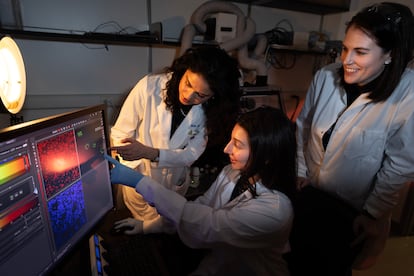How the menstrual cycle is regulated: Science points to internal body clock and mitigates lunar influence
New research suggests a mechanism — like the circadian timer that sets the tempo of life — drives the rhythmicity of the 28-day ovarian cycle

The first day of menstruation is the starting point of a very complex vital process that science does not yet fully understand: the ovarian cycle. The first phase of this phenomenon begins with the menstrual period, which usually lasts about 28 days, and also involves, apart from menstrual bleeding, the growth of the ovarian follicles until a mature egg is released into the fallopian tubes and the degradation of the endometrium before the onset of a new menstrual cycle. All this happens periodically during a woman’s fertile life at a more or less constant rate, but scientists still do not know what determines the timing of these cycles and why each phase lasts as long as it does. Because of the temporal similarities, some experts have suggested a link between this phenomenon and the lunar cycle, but this theory, which has produced limited and contradictory results, has always generated controversy within the scientific community. New research, published Wednesday in the journal Science Advances, adds to the understanding of this process and suggests that, rather than the lunar phases or any other external variable, it is probably an internal body clock — like the circadian chronometer that marks the compass of life — that regulates the ovarian cycle.
According to Claude Gronfier, a scientist at the Neuroscience Research Center in Lyon, France, and one of the authors of the study, the traditional explanation for why the menstrual cycle lasts 28 days “is that it results from a fine balance between endocrine processes” that lead to the different phases of the phenomenon.
After analyzing nearly 27,000 menstrual cycles in 2,300 European women and another 4,800 from 721 North Americans, the authors of the study found evidence that “it is more than likely” that the rhythmic characteristics of the menstrual cycle are explained by an internal mechanism of the body similar to the circadian clock, the central biological timer located in the hypothalamus, that tells time to the rest of the body.
“What our article shows is that these processes do not simply follow one another, in such a way that each one begins when the previous one ends. Our results strongly suggest that a clock-like mechanism drives the rhythmicity of the menstrual cycle, such that its periodicity remains within a certain range and oscillates around the intrinsic rhythmicity of the cycle (which varies between women),” explains Gronfier. Thus, this synchronizing mechanism can even correct the fluctuations that occur in a specific cycle, in the same way that it takes a few days to fix the circadian imbalance that occurs after an intercontinental trip, for example. “If the [ovarian] cycle lengthens, for whatever reason, this clock-based process adapts to quickly shorten it, and if it shortens, this clock-based process adapts to lengthen it as well,” Gronfier adds.
Gronfier and his team’s hypothesis has not come out of nowhere. In the article, the researchers say that there is already “some evidence” that the phases of menstrual cycles can also be under the influence of circadian rhythms and that an alteration of this vital rhythm is also associated with dysfunctions in menstrual function. Juan Antonio Madrid, professor of physiology and director of the Chronobiology and Sleep Laboratory at the University of Murcia, Spain, points out that there is a connection between the circadian clock and menstrual cycles, but with nuances: “Women with irregular cycles tend to have worse daily circadian rhythms and poorer sleep quality. Sleep and good circadian rhythms regulate the menstrual cycle and, in turn, the menstrual cycle influences sleep. If we divide the ovarian cycle in half and place ovulation in the middle, we see that the hormones change in each phase and there are also temperature changes.” But that does not mean, the chronobiologist points out, that it is the circadian clock that modulates the menstrual cycle. “In the article, they believe that there is an internal clock similar to the circadian clock that we have in the brain, but they do not identify what it is or where it is. We cannot say that the circadian clock is controlling the menstrual cycle,” notes Madrid, who did not participate in the study.
Gronfier also admits that they do not know how circadian rhythms determine the length of menstrual cycles. “We don’t know yet, but we believe that the circadian synchronization system — well known for its regulatory role in a large number of physiological rhythmicities, such as the sleep-wake cycle, cognition, memory, metabolism, temperature, and cell cycle, just to name a few — is involved, since it is involved in another well-known rhythmic process that we call seasonality or annual rhythmicity (which exists not only in animal species that reproduce seasonally, but also in humans). Therefore, the almost monthly rhythm could also originate from the circadian oscillation.”
Controversial moon effect
The authors also analyze the potential effect of the lunar cycle (which lasts 29.5 days) and do not rule out this theory, but specify that the links found are “weak.” In a context of contradictory scientific literature — there are studies that show a more frequent appearance of menstruation after the new moon while others, on the contrary, point out data in favor of the appearance of the period when the moon is brighter or just before and after the full moon — the authors of the research observed that the menstrual cycle began more frequently on a crescent moon in Europe, while in North America it occurred more frequently on a full moon. “We do not have an explanation for this difference between the continents, but we believe that a more in-depth study of this issue is justified,” they state, although some hypotheses are proposed.
Madrid, on the other hand, is more reticent about the influence of the lunar cycle: “It was a very nice hypothesis, but if it were truly a synchronizer and not a mere coincidence, it is difficult to understand biologically that a different synchronization mechanism exists among women in North America and Europe. There is a slight increase in menstruation, but it does not coincide in different places and the statistical evidence is very weak.”
The authors admit that more work and studies in larger populations are needed to test their hypotheses “and unravel the mechanisms” behind this potential internal clock, but their findings open the door to studying chronobiological approaches to address, for example, dysfunctions in the ovarian cycle.
Sign up for our weekly newsletter to get more English-language news coverage from EL PAÍS USA Edition
Tu suscripción se está usando en otro dispositivo
¿Quieres añadir otro usuario a tu suscripción?
Si continúas leyendo en este dispositivo, no se podrá leer en el otro.
FlechaTu suscripción se está usando en otro dispositivo y solo puedes acceder a EL PAÍS desde un dispositivo a la vez.
Si quieres compartir tu cuenta, cambia tu suscripción a la modalidad Premium, así podrás añadir otro usuario. Cada uno accederá con su propia cuenta de email, lo que os permitirá personalizar vuestra experiencia en EL PAÍS.
¿Tienes una suscripción de empresa? Accede aquí para contratar más cuentas.
En el caso de no saber quién está usando tu cuenta, te recomendamos cambiar tu contraseña aquí.
Si decides continuar compartiendo tu cuenta, este mensaje se mostrará en tu dispositivo y en el de la otra persona que está usando tu cuenta de forma indefinida, afectando a tu experiencia de lectura. Puedes consultar aquí los términos y condiciones de la suscripción digital.
More information
Últimas noticias
‘Fallout’ or how the world’s largest company turned an anti-capitalist apocalyptic Western into a phenomenon
From inflation to defending migrants: Eileen Higgins and Zohran Mamdani inaugurate the new Democratic resistance against Trump
EU’s prestige at stake with proposal to fund Ukrainian war effort with Russian assets
Mustafa Suleyman: ‘Controlling AI is the challenge of our time’
Most viewed
- ‘El Limones’ and the growing union disguise of Mexican organized crime
- Christian Louboutin: ‘Young people don’t want to be like their parents. And if their parents wear sneakers, they’re going to look for something else’
- ‘We are dying’: Cuba sinks into a health crisis amid medicine shortages and misdiagnosis
- The low-cost creative revolution: How technology is making art accessible to everyone
- A mountaineer, accused of manslaughter for the death of his partner during a climb: He silenced his phone and refused a helicopter rescue











































